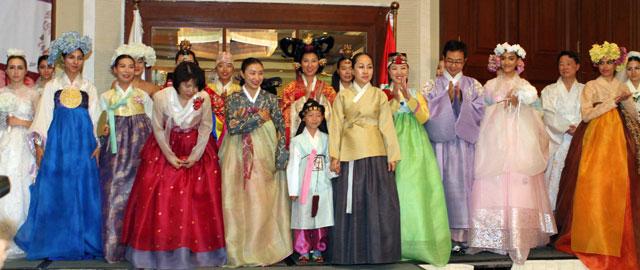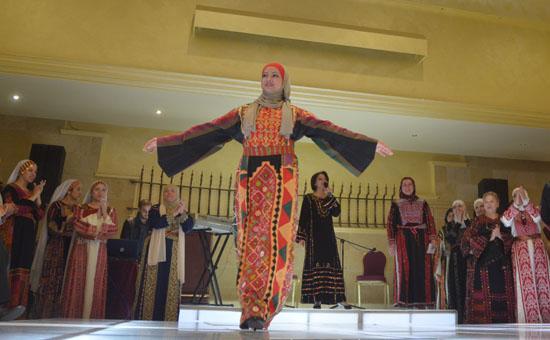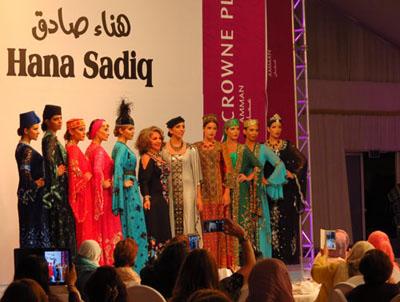You are here
Ever growing Korean-Jordanian cultural ties blossom
By Abeer Numan - Nov 01,2014 - Last updated at Nov 01,2014

AMMAN — Jordanians and Koreans held a joint fashion show on Friday, showcasing Jordanian, Palestinian and Korean traditional costumes in a bid to foster cultural exchange and raise awareness of their traditions, ancient heritage and values.
Organised by the Jordanian-Korean Friendship Association (JKFA), in cooperation with the embassy of South Korea in Amman, the fashion show introduced the audience to a vast collection of elegant embroidered Jordanian and Palestinian dresses, known as thawb, depicting the heritage of several cities.
It also introduced them to the beauty of the “hanbok”, the word used today to refer to the traditional Korean dress, which dates back as far as the Three Kingdoms Period (57 BC — 668 AD).
Models from both Jordan and Korea showed different types of the hanbok, with the first part of the hanbok show, focusing on traditional ones that were worn by Korean royalty and nobles in ancient times while the second part showed modernised versions of the hanbok, including the special one used at weddings.
Despite the long history of the hanbok, its basic composition has remained fairly constant through the ages, a JKFA representative explained.
“The fact that this costume survived so many social, political and environmental changes within Korea for so many centuries attests to the Korean people’s deep loyalty and respect for tradition,” she noted.
Each element of a hanbok holds deep symbolic significance. In the past, different colours revealed specific information about the wearer. Purple ribbons were worn only by married women, whose husbands were still alive, whereas dark blue cuffs on the sleeves showed that the woman had sons.
Among the most important symbols that appeared on the hanbok, that was designed for Kings is that of the dragon, the mythic, sacred animal, that was believed to be the master of both land and sky.
The entire nation of the Koreans wore the hanbok on a daily basis up to the early 20th century, when the effects of Westernisation started to root it out, she added.
A short briefing was given about the costumes, their origin, patterns and uniqueness as Jordanian, Palestinian and Korean models took the stage at the show, whose proceeds are going to the King Hussein Cancer Foundation (KHCF).
Palestinian and the Jordanian dresses were mainly from Hebron, Beersheba, Jaffa, Jericho, Jerusalem, Ramallah, Gaza, Salt, Ajloun, Irbid, Umm Qais and Aqaba with the models wearing beautiful head scarves that were very common in the past days and cultures were identified with them.
“We are showcasing traditional dresses, everything from the past… our heritage, and we are trying to make them last, so that new generations will embrace them,” Ola Nahar, a contributor who was working with the models depicting the Jordanian and Palestinian dresses before going on stage told The Jordan Times.
Addressing the attendees, JKFA Chairman Ramzi Khouri highlighted the importance of the show as a venue for cultural interaction, focusing on fashion, beauty and harmony.
Jung-Hyun Lee, Korean fashion expert, who was helping models dress up, said: “I think the most important part of the show is introducing Korean traditional costumes to the people of Jordan. I guess all the dresses are extraordinary. Now, in daily life, we have new designs but we can mix and apply the traditional hanbok on modern styles. Today, we have modernised hanbok so people have started wearing in modern times.”
Commenting on common features between the hanbok and the Palestinan and Jordanian thawb, Lee said:” I was impressed by the colours, and the embroidery. I think there is a similarity in colours.”
Expressing her pride in her first modelling experience, Minas Abu Al Halaw, who is also a 5th year University of Jordan pharmacy student, wore a Jerusalem-style Palestinian dress.
“I highly appreciate traditional clothes and today, we are displaying both the Jordanian and Palestinian dresses, which are really beautiful,” she told The Jordan Times.
Adding more liveliness and richness to the fashion show, two Korean children, an eight-year old girl, named Bohye and her brother Joo-ahn Lee, seven, participated in the show depicting traditional clothes of Korean children that are nowadays only put on for very important occasions.
“I am kind of nervous,” Bohye said ahead of the show. “We want to take part because we want to show Korean culture, she said, while her father explained that the traditional clothes are made of fine fabric, mainly silk, and they are colourful and beautifully ornamented. Also, there was special footwear the children were wearing.
Korea’s Ambassador to Jordan Choi Hong-ghi said the fashion show was the “final event” of Korean Cultural Week, expressing hope that it has helped bring the Jordanians and the Koreans closer.
“I sincerely hope it will lead to bringing the people of the two countries closer and advance our relations. Also, I am pleased to see the Jordanian and the Palestinian dresses. I noticed their diverse and beautiful costumes. This has raised my awareness of their traditions.”
The event included several Korean musical performances and dances to further acquaint the audience with the Korean culture.
Korean Cultural Week, which concluded on October 31, included several activities, including Korean Film Week and the Korean speech competition that was held at the University of Jordan.
Their Highnesses Prince Mired and Princess Dina Mired, director general of the KHCF, attended the fashion show, as well as, several senior Jordanian and Korean embassy officials.
Related Articles
Nimat Saleh glided on stage in a traditional dress worn in Jordan, Palestine and Syria, proudly showing it to the audience as a sign of unity between Arab countries and the Levant in particular.
HANOI — Made from delicate silk, intricately embroidered and with vast, flared sleeves: Vietnamese 19th-century outfits do not seem a perfec
AMMAN — Brightly coloured clothes, beautifully laid tables and a runway cutting across the room — Amman’s glitterati showed up to view the p

















